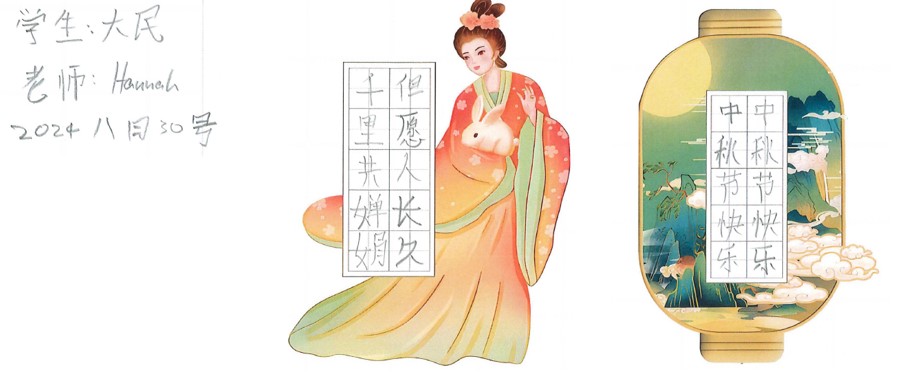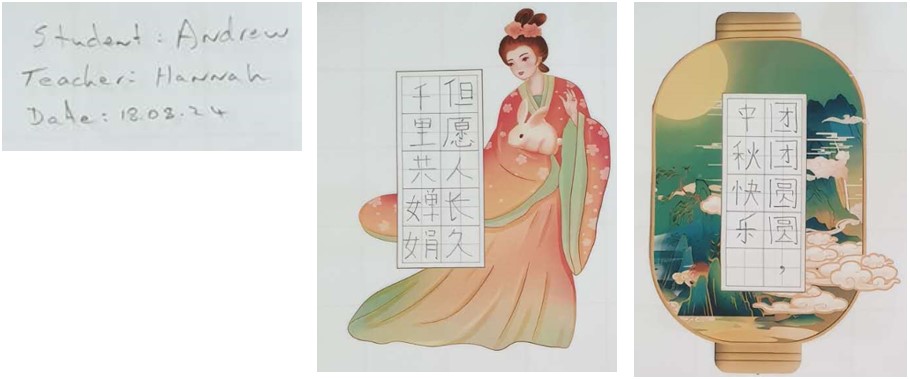The Mid-Autumn Festival 2024
The Mid-Autumn Festival, one of China’s most significant cultural celebrations alongside Chinese New Year and the Dragon Boat Festival, is held on the 15th day of the 8th lunar month. With deep historical roots dating back to the Zhou Dynasty (ca. 1050–221 BCE), this festival is associated with moon worship and harvest festivities. It is a time for family reunions, cultural expressions, and the celebration of the full moon.
During CI teaching team’s visit to Newcastle around the end of August 2024, CI staff and students enjoyed an impromptu and wonderful moment to practise “The Moon Represents My hearts”. A beautiful song to celebrate the Mid-Autumn Festival!
"The Moon Represents My Heart" by CI Staff and Students
The Mid-Autumn Festival is rich in mythology, particularly the famous legend of Chang'e, the moon goddess. This tale of love and betrayal is central to the festival’s lore and has inspired many Chinese poems, adding a nostalgic and philosophical depth to the celebrations.
Traditional custom of the Mid-Autumn Festival includes moon worship, moon gazing, eating mooncakes, and lantern displays that create a beautiful spectacle.
In modern times, the celebration of the Mid-Autumn Festival has become more diverse and engaging. While preserving its traditional charm, new and creative ways of celebration tend to blend with modern lifestyles.
Making Mooncake and Exchanging Gift
By the Song Dynasty (960-1279), the Mid-Autumn Festival had evolved into a celebration for all and become a public holiday. Friends and family exchange mooncakes (Chinese: 月饼; pinyin: yuè bǐng), fruits, and other snacks symbolizing good wishes.
Making mooncakes together has become a fun and enjoyable activity for families and friends.
Mooncakes, once taking up to a month to prepare, can now be enjoyed with more ease. Modern moulds and ovens have significantly shortened the preparation time, and the variety of flavours has expanded to include options like peanut butter and jelly.
Students at the Confucius Institute celebrate this special occasion by sharing their Chinese calligraphy and extending Mid-Autumn Festival greetings to everyone: 但愿人长久,千里共婵娟 (Pinyin: dàn yuàn rén cháng jiǔ, qiān lǐ gòng chán juān; English translation: May we all be blessed with longevity. Though thousands of miles apart, we are still able to share the beauty of the moon together.) and 中秋节快乐 (Pinyin: zhōng qiū jié kuà ilè; English translation: Happy Mid-Autumn Festival)!






Moon Gazing
Since the Sui (581 - 618) and Tang (618 - 907) dynasties, moon gazing (Chinese: 赏月; pinyin: shǎng yuè) during the Mid-Autumn Festival has been a cherished tradition, particularly among scholars. On quiet autumn nights under the bright stars and full moon, a unique harmony between human and nature is appreciated. This sentiment also embodies a distinct Chinese romanticism that foster inspiration of writing or exchanging poetic verses.
In the past, people would sit in their courtyards to gaze at the moon. Today, many bring picnic blankets to nearby parks, observe the full moon with telescopes, and capture the moment with their smart phones to share on social media.
Making and Displaying Lantern
Originated over 2,000 years ago during the Western Han Dynasty (202 BC – 9 AD), Chinese lanterns (Chinese: 灯笼; pinyin: dēng lóng) symbolize hope and reunion. Nowadays, lantern-making competitions and exhibitions are often organized to let skilled artisans showcase their talent.
Lanterns come in a wide variety of styles and are often decorated with intricate paper cuttings, calligraphy, paintings, and poetry. In cities like Guangzhou and Hong Kong, these dazzling lanterns not only enhance the festivity but also add to the special decoration of the cityscape during the celebration.
Guessing Riddle
Lantern riddles (Chinese: 灯谜; pinyin: dēng mí) originated during the Spring and Autumn Period (720 BCE - 480 BCE), are a literary game rich in satire, moral lessons, humour, and wit. The practice of writing riddles on slips of paper and hanging them on colourful lanterns for people to guess began in the Southern Song Dynasty (1127 - 1279). Utilizing the nuances of Chinese characters, lantern riddles often play with the meanings of words and use phrases or poems to create clever puzzles.
These days, the younger generations would incorporate English riddles into the traditional game that allow their foreign friends to participate. This can break down language barriers, encourages cultural exchange, and help people learn more about each other’s languages and traditions.
Cosplay Party
Cosplay (Chinese: 角色扮演; pinyin: jué sè bàn yǎn) was introduced to China in 1993 and has developed significantly over the years. There are now tens of millions of cosplay enthusiasts in China. Some are enthusiastic about photography while others enjoy participating in club events and planning stage performances. The process of making costumes and props together has also become a highly enjoyable activity.
A cosplay party with the Mid-Autumn Festival theme is delightful and creative. Cosplay enthusiasts prepare traditional costumes and reenact ancient legends such as the story of Chang'e, the moon goddess.
The Mid-Autumn Festival continues to thrive as a celebration that honours tradition while embraces modern influences. The festival brings people together in a unique blend of cultural heritage and contemporary lifestyle.
The University of Newcastle acknowledges the traditional custodians of the lands within our footprint areas: Awabakal, Darkinjung, Biripai, Worimi, Wonnarua, and Eora Nations. We also pay respect to the wisdom of our Elders past and present.